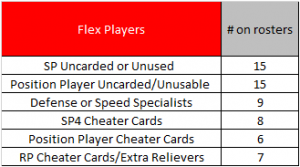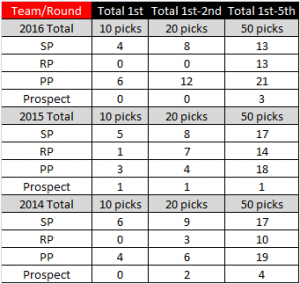Before our much anticipated Rookie Draft, we perform some annual housekeeping.
We begin by crowning our 2014 champion, Steve Gaiski, whose Arrogant Bastards (named for the Stone Brewing Company ale) faced eight elimination games enroute to their very first OOTL World Series title. Steve received our traveling trophy and a plaque to keep.
Our vote on league officers maintains Brandon Matlock as President, Craig Dolan as Vice-President and Bob Boyd as Secretary-Treasurer. Executive committee first alternate is John Ingiosi; second alternate, Kevin Baker.
2014 Player of the Year voting results: Jacoby Ellsbury, Brandon Moss and Josh Donaldson.
2014 Pitcher of the Year voting results: Clayton Kershaw, Justin Verlander and Derek Holland.
Both runners-up were summarily released by the Speakers during the Rookie Draft!
Rule clarifications:
Rule 3.07 must be clarified to allow for only one (1) previously carded player designated as injured reserve per team roster per season.
Pitchers that can both start and relieve are not limited to only the number of *** relief appearances as in the corresponding MLB season. The combination of starts and relief appearances cannot exceed total *** starts or *** total games.
Following a mid-series injury that lasts more than one (1) game during the playoffs, the affected team may activate any inactive player on its roster.
Rule reminders:
Rule 2.12 (a) Should rare play result 28 appear consecutively, pitchers with positive control roll to potentially prevent a walk. If the pitcher prevents a walk, the count shall be three (3) balls. (On the initial 28, roll for a negative control pitcher to potentially walk the batter.
Rule 2.19 When 1st base is occupied, the runner is being held on (HO) and a slow (S) left-handed batter, board result 12 becomes a double play.
Rule 2.22 In 8th inning or later, the score must be two (2) runs closer than indicated on the boards to execute a successful pickoff play. This also applies to the 37/39 pickoff chart.
Rules discussion:
1 – (Brandon, Barry & Steve) Eliminate Rule 2.12 (e) Runner on Second board play result 26 requires a defensive roll for fielding: Fielding 1 – Batter out at 1st, runner holds; A-2B, PO-1B.
Fielding 2 & 3 – Batter out at 1st, runner advances one base; A-2B, PO-1B.
(Fails 5-6.)
2 – (Brandon) Edit Rule 5.06. Except for injury or ejection, no starting pitcher may be removed from a game unless one of the following criteria has been met:
a) Must face a minimum of nine (9) batters if no runs have been scored. After facing the 9th batter, the starting pitcher may be removed anytime.
b) Starting pitcher may be removed prior to nine (9) batters faced if one run has scored.
c) No restrictions during the post-season.
(Passes 6-5, but with eliminating c) above.)
3 – (Brandon) Change the fatigue chart for Q3* and Q4* relievers. The fatigue chart would remain as is for Q2* relievers OR any pitcher who can both start and relieve. Q3* and Q4* relievers would begin to fatigue at seven (7) batters as current, but instead of losing one (1) grade, they would lose two (2) grades. At ten (10) batters, they would lose an additional three (3) grades. The Q3* or Q4* reliever would continue losing three (3) grades at every additional interval.
(Passes 7-4.)
4 – (Brandon) Change the Steal Chart and Hit and Run rules:
a) A team can hit and run with any player. Two (2) 31s are no longer required to call hit and run. However, a team would be limited to calling hit and run no more than five (5) times in a nine (9) inning game. In extra innings, a team can only call hit and run twice, regardless of the number of times the hit and run was called during the first nine (9) innings.
(Fails.)
b) Change the steal chart for C, D, & E runners on steals of 2nd base as follows:
C – Anytime
D – Remove the out restrictions; allow the runner to be able to run either up or down two (2) runs. After the 6th inning, all restrictions are removed.
E – Remove the out restrictions. After the 6th inning, runner can run either up or down four (4) runs.
(Passes 6-5.)
c) Hit & Run penalties under the SAL chart remain.
d) Remove the penalties listed on the SAL chart: If a runner is ineligible to steal, SALs lose numbers as follows: A=(-0), B=(-2), C=(-5), D=(-7), E=(-10), F=(-12), G=(-15), and R=(-20); and then, is subject to Master Game reductions, (i.e., stealing 3rd & home).
(Fails.)
e) Create a Pitchout rule. The defensive manager may call a pitchout once an offensive manager has decided to call either hit and run or a straight steal with only a runner on 1st. The pitchout may be called only once per game as long as neither team leads by more than three (3) runs. Once a pitchout is called, the runner on first will automatically attempt a straight steal, automatically losing 12 points on the stolen base attempt. Also factor the catcher’s arm, but DO NOT calculate the pitcher’s MF.
(Fails.)
5 – (Barry & Brandon) If above Hit & Run rule fails and 2014 rules continue to apply, eliminate the roll for a foul ball on the hit and run play.
(Passes 9-2.)
6 – (John) During the regular season allow any starting lineup batter with steal attempts remaining to hit and run with no reductions; dice result 13 would be two (2) strikes on the batter and a steal attempt; dice result 14 would be two (2) balls on the batter and a steal attempt. Replacement batters/runners and post-season would use present rules. batter would need to have two 31’s on his card.
Also reduce steal attempts from 80% to 70%. (APBA uses the A thru R to reduce the number of opportunities to steal and the 70% will do the same thing.) Straight steals use the present rules.
Overuse of stolen base attempts result in the player returning to the draft pool at the end of the season. If excessive, a draft pick could also be lost (7th round ) or whatever seems appropriate.
(Fails 3-8.)
6a – (John) Player overuse (G, GS, IP, AB, SBA) results in immediate release. NO games will be replayed.
(Passes.)
7 – (Craig) 80% steals should be eliminated and 100% of steal usage should be allowed. It is a waste of calculations and limits the value of key players.
(Fails 1-10.)
8 – (Bob Silks & Barry) Current game conversion chart for 100 games should be used for steal attempts.
(Fails.)
9 – (Craig) If an owner makes a mistake at the draft resulting in an illegal roster and it is not caught by the Executive Committee at the draft, the owner is entitled to an additional drop/add move(s) when the error is discovered (before roster approval) in order to make the roster legal. He will not have any transactions voided or be forced to keep a player he had cut.
(Fails 1-10.)
10 – (Craig) If a pitcher played a position in MLB other than pitcher, he is permitted to be used at that position in the OOTL but is still not permitted to bat. Examples of usage could include a defensive replacement or even a double switch to put the pitcher in left field while a left handed reliever pitches to a batter and then reinserted to pitch to the following batter. This was done more frequently in the past in the MLB and is very rare now but was done this year by the Padres. If used in a game, the pitcher is not pitching, it would count as a game against his usage.
(Fails 2-9.)
11 – (Craig) All starting pitchers without relief appearances in MLB can also relieve in OOTL playoffs on one day’s rest after a start. Once these starting pitchers pitch in relief, they are not allowed to start another game in that playoff series. Their relief usage would be judged as any Q4* reliever.
(Fails 3-8.)
12 – (Craig) If an owner quits OOTL and is replaced, any draft picks traded by that owner will be replaced by a supplemental draft pick at the end of the corresponding round.
(Passes 11-0.)
13 – (Bob Silks) Limit player Batter Characteristics to +/- 7.
(Fails 2-9.)
14 – (Bob Silks) Make either the first 8 or first 9 on a hitter’s card a hit.
(Fails 3-8.)
15 – (Barry) Eliminate Rule 2.20: ability to switch from Fielding One to either Fielding Two or Three if one of those results is better for the defense.
(Passes 6-5.)
16 – (Brian) Reintroduce the BROWN BOARD, which deals with dropped throws and allows for trail runners to take extra bases.
(Any manager playing Brian in the 2nd or 3rd Period may agree to trial the Brown Board during that series to become more familiar with its nuances.)
17 – (Brandon) No more than two (2) XB J-4 players may be selected in one draft.
(Fails 2-9.)
18 – (Steve) Runner on First board – if offense calls hit and run and card result is 6, no further “double roll” takes place (to potentially change to a 3). All other scenarios pertaining to Rule 2.24 still apply.
(Passes 6-5.)
19 – (Brandon) Edit Rule 11.04 to read: Stats are due following the 10th day after each period:
Stats submitted more than a week late result in an offense. A first time offense will be the forfeiture of a seventh (7th) round draft selection in the next Rookie Draft. The second offense will result in the forfeiture of a sixth (6th) round selection. The third offense will result in the forfeiture of a fifth (5th) round selection. Any additional offenses can result in losing multiple draft picks. If the guilty manager no longer owns the designated forfeited selection, the next higher selection must be forfeited.
Any playoff team that has not submitted stats is not eligible to compete in that season’s playoffs until stats are submitted. Non-submission of stats can result in removal from the league.
The Executive Committee can take into account extenuating circumstances prior to applying any penalties.
(Passes 10-1.)
20 – (Barry) Eliminate Rule 2.20: A defensive manager that rolls Fielding One has the option of any of the three Fielding results. This no longer applies to Results 36-41 or Rare Play board results.
(Already passes as rule proposal 15 above.)
Following a brief break, the time had come for Mike to make the first selection of this year’s Rookie Draft.

